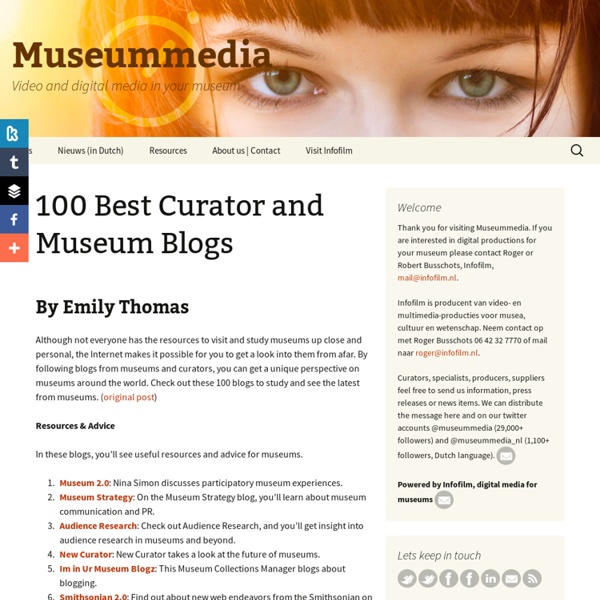100 Best Curator and Museum Blogs
Although not everyone has the resources to visit and study museums up close and personal, the Internet makes it possible for you to get a look into them from afar. By following blogs from museums and curators, you can get a unique perspective on museums around the world. Check out these 100 blogs to study and see the latest from museums. (original post) Resources & Advice In these blogs, you’ll see useful resources and advice for museums. Curators & Staff Check out these blogs to learn about museums from their curators and other staff. Art In these blogs, you can learn about art museums. Children & Education See fun activities and more in these blogs about children’s and education museums. The Learning Team, The Manchester Museum: Find learning resources and more through the Manchester Museum blog.What’s Happening at The Children’s Museum of Memphis? History & Culture These blogs share the happenings of history and culture museums. Science Miscellaneous
41 Ways Museums Are Merging Social and Tech to Engage Audiences
In preparation for the IMLS webinar series- Connecting to Collections- I’ve been thinking about some of my favorite ways that museums are merging social and tech to engage audiences. Part of the series, Using Social Media to Tell Your Collection’s Stories, will take place from 2:00pm to 3:30 pm EDT on Thursday, October 28th, 2010. I’m pleased to be serving as commentator, and working with presenter Nancie Ravenel (@NancieRavenel) of the Shelburne Museum. Technology is a powerful tool for cultivating community, and the merging of social and tech in museums is occurring more and more frequently. Let’s start with some museums that are making the most of social media and online community engagement’s most powerful and basic building blocks: 1. 2. 3. 4. 5. 6. 7. 8. 9. 10. Museums are taking interaction even further and building upon Twitter, Facebook, YouTube, Flickr, mobile applications and web-based platforms. 11. 12. 13. 14. 15. 16. 17. 18. 19. 20. 21. 22. 23. 24. 25. 26. 27. 28. 29.
Technéo - [Développez votre entreprise]
| Imprimer | Note utilisateur: Les budgets de fonctionnement se réduisent et obligent les dirigeants de structures publiques et parapubliques à adapter leur stratégie et leur organisation aux contraintes croissantes. Nous devons "profiter" de ce contexte pour repenser les modèles économiques de ces structures dans le cadre d'une économie plus participative. Pour ce faire, elles devrons avoir des outils et des méthodes stratégiques afin de mutualiser les moyens, co-développer des offres sans « concurrencer » le privé. L'exercice est subtil mais doit être mené si nous voulons conserver une certaine qualité de service pour tous. Ce livre propose aux dirigeants de structures publiques et parapubliques telles que les "grosses associations" de mission de service publique de travailler par étape : Une méthode utile, pragmatique et collaborative permettant à toutes ces structures de se repenser elles-mêmes pour faire face avec leurs parties-prenantes aux difficultés actuelles et à venir...
Twitter et les musées….oui ou non ? et pourquoi ?!
DIAGNOSTIC SYSTEME D'INFORMATION - [Développez votre entreprise]
| Imprimer | Note utilisateur: Les budgets de fonctionnement se réduisent et obligent les dirigeants de structures publiques et parapubliques à adapter leur stratégie et leur organisation aux contraintes croissantes. Nous devons "profiter" de ce contexte pour repenser les modèles économiques de ces structures dans le cadre d'une économie plus participative. Ce livre propose aux dirigeants de structures publiques et parapubliques telles que les "grosses associations" de mission de service publique de travailler par étape : - analyse des parties-prenantes et des sources de financements, - analyse des métiers et des équipements,- mise en perspective des principaux partenaires,- définition d'offres de service collectives,- définition des modèles économiques de la structure,- de la stratégie à l'organisation,- définition des outils de pilotage de la structure,- les stratégies de contractualisation,- l'amélioration continue en action.
Research: Social Media Audiences and the Museum
The following research was conducted on behalf of MuseumNext and Sumo in April 2011 by an independent market research company with a sample of 500 UK residents. This survey aims to provide some context for museums looking to use social media. Please note: Please credit MuseumNext should you wish to reproduce this survey.
Related:
Related:



